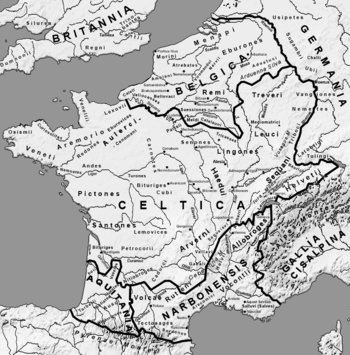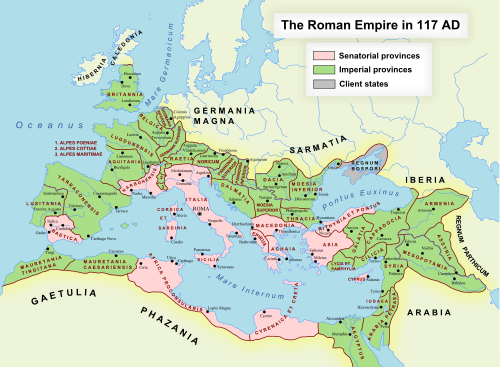Gallia Narbonensis
| Provincia Gallia Narbonensis | |||||
| Province of the Roman Empire | |||||
| |||||
 | |||||
| Capital | Narbo Martius | ||||
| Historical era | Antiquity | ||||
| • | Established | 121 BC[1] | |||
| • | Visigothic conquest | 5th century | |||
| Today part of | | ||||


Gallia Narbonensis (Latin for "Gaul of Narbonne", from its chief settlement)[n 1] was a Roman province located in what is now Languedoc and Provence, in southern France. It was also known as Provincia Nostra ("our Province"), from its having been the first Roman province north of the Alps, and as Gallia Transalpina ("Transalpine Gaul"), distinguishing it from Cisalpine Gaul in northern Italy. It became a Roman province in the late 2nd century BC. Its boundaries were roughly defined by the Mediterranean Sea to the south and the Cévennes and Alps to the north and west. The western region of Gallia Narbonensis was known as Septimania.
Names
The province of Gallia Transalpina ("Transalpine Gaul") was later renamed Gallia Narbonensis, after its newly established capital of Colonia Narbo Martius (Narbonne), a Roman colony founded on the coast in 118 BC. The Romans had called it Provincia Nostra ("our province") or simply Provincia ("the province"). The term has survived in the modern French and Occitan names of the eastern part of the area (French Provence, Occitan Provença), now a région of France.
Founding
By the mid-2nd century BC, Rome was trading heavily with the Greek colony of Massalia (modern Marseille) on the southern coast of Gaul. Massalia, founded by colonists from Phocaea, was by this point centuries old and quite prosperous. Rome entered into an alliance with Massalia, by which it agreed to protect the town from local Gauls, nearby Aquitani, sea-borne Carthaginians and other rivals, in exchange for a small strip of land that it wanted in order to build a road to Hispania, to assist in troop transport. The Massalians, for their part, cared more for their economic prosperity than they did for territorial integrity. In this strip of land, the Romans founded the town of Narbonne, which turned out to be a major trading competitor with Massalia. It was from this that the province of Transalpine Gaul was founded.
During this period, the Mediterranean settlements on the coast were threatened by the powerful Gallic tribes to the north, especially the tribes known as the Arverni and the Allobroges. In 123 BC, the Roman general Quintus Fabius Maximus (later additionally named Allobrogicus) campaigned in the area and defeated the Allobroges and the Arverni under king Bituitus. This defeat substantially weakened the Arverni and ensured the further security of Gallia Narbonensis.
Later history
Control of the province, which bordered directly on Italia, gave the Roman state several advantages: control of the land route between Italy and the Iberian peninsula; a territorial buffer against Gallic attacks on Italy; and control of the lucrative trade routes of the Rhône valley between Gaul and the markets of Massalia. It was from the capital of Narbonne that Julius Caesar began his Gallic Wars.
The area became a Roman province in 121 BC,[1] originally under the name Gallia Transalpina (Transalpine Gaul). The name distinguished it from Cisalpine Gaul on the near side of the Alps to Rome. In 40 BC, during the Second Triumvirate, Lepidus was given responsibility for Narbonese Gaul (along with Hispania and Africa), while Mark Antony was given the balance of Gaul.[2]
Emperor Diocletian's administrative reorganization of the Empire in c. AD 314 merged the provinces Gallia Narbonensis and Gallia Aquitania into a new administrative unit called Dioecesis Viennensis (Diocese of Vienne) with the capital more to the north in Vienne. The new diocese's name was later changed to Dioecesis Septem Provinciarum (Diocese of the Seven Provinces), indicating that Diocletian had demoted the word "province" to mean a smaller subdivision than in traditional usage.
Galla Narbonensis and surrounding areas were incorporated into the Visigothic Kingdom between AD 462 and 477, permanently ending Roman political control. After the Gothic takeover, the Visigothic dominions were to be generally known as Septimania, while to the east of the lower Rhone the term Provence came into use.
List of Proconsular governors of Gallia Narbonensis
(This list is based on A.L.F. Rivet, Gallia Narbonensis (London: Batsford, 1988), pp. 79, 86f.)
- Gnaeus Pullius Pollio -- 18-16 BC
- Titedius Labro -- AD 12-15
- Manlius Vibius Balbinus -- 15-17
- Torquatus Novellus Atticus -- 30-34
- Titus Mussidius Pollianus -- 34-37
- Titus Vinius Rufus -- 54-60
- L. V[...]dius Bassus -- c. 77
- Gaius Iulius Cornutus Tertullus -- before 78
- Aulus Larcius Priscus -- 103-109
- Marcus Acilius Priscus Egrilius Plarianus -- 118-120
- Lucius Anininius Sextius Florentinus -- c. 124
- Lucius Aurelius Gallus -- 124-127
- Lucius Novius Crispinus Martialis Saturninus -- 144-5
- Gaius Seius Calpurnius Quadratus Sittianus -- before 150
- Lucius Cestius Gallus Cerrinius Iustus Lutatius Natalis -- between 165 and 183
- Gnaeus Cornelius Aquilius Niger -- between 138 and 192
- Lucius Fabius Cilo Septiminus Catinius Acilianus Lepidus Fulcinianus -- between 180 and 192
- ...]dius Titii filius -- 2nd century
- Lucius Ranius Optatus Novatus -- between 197 and 214
- Ignotus, allegedly killed for supporting Geta -- c. 210
- ...]us -- between 210 and 230
- Tiberius Claudius Paulinus -- 216-217
- Gaius Aemilius Berenicianus Maximus -- between 222 and 235
- Iulianus -- between 222 and 235
Notes
- ↑ The name is also variously expressed as Narbonnese Gaul, Narbonian Gaul, and Narbonensian Gaul.
References
Coordinates: 44°00′00″N 4°00′00″E / 44.0000°N 4.0000°E
